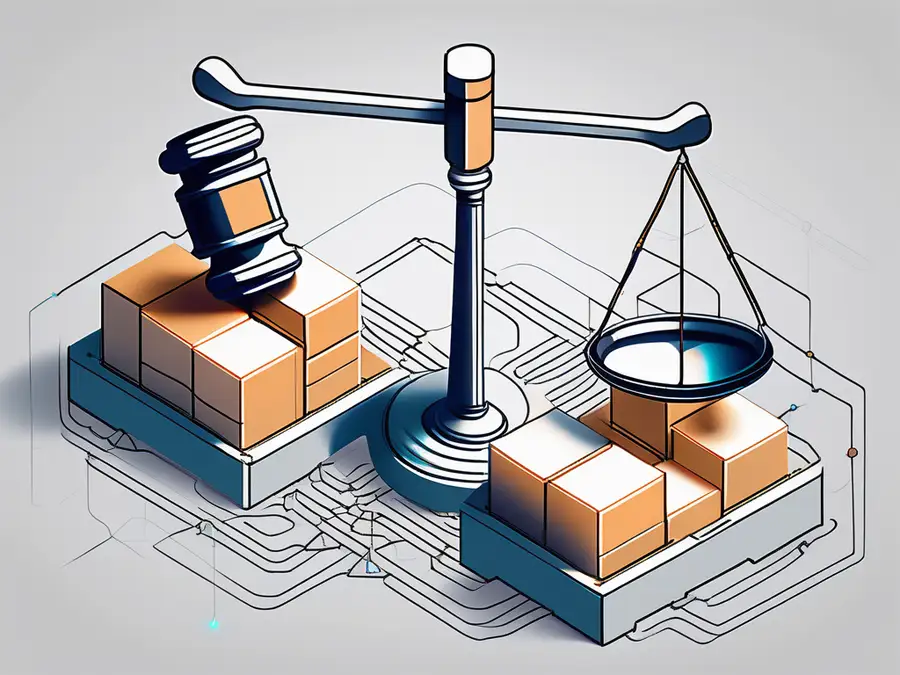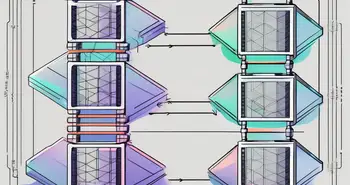A Handbook on Blockchain Governance

Blockchain technology has revolutionized various industries and has the potential to restructure our society as we know it. However, in order for blockchain to reach its full potential, a proper governance framework needs to be put in place. In this ultimate guide, we will dive deep into blockchain governance, its importance, different types, and the challenges it faces. Let's get started!
Understanding Blockchain Governance
Definition and Importance of Blockchain Governance
Blockchain governance refers to the rules and processes that govern the operation and evolution of a blockchain network. It involves decision-making, consensus mechanisms, and ensuring the network remains secure, transparent, and accountable.
Effective blockchain governance is crucial for the successful implementation and adoption of blockchain technology. It helps to ensure that the network is immune to tampering, maintains a high level of trust, and fosters innovation and collaboration among its participants.
Key Principles of Blockchain Governance
There are several key principles that guide blockchain governance:
- Decentralization: Blockchain governance aims to distribute decision-making power among network participants, reducing the influence of any single entity and promoting transparency and fairness.
- Consensus: Consensus mechanisms, such as proof-of-stake or proof-of-work, ensure that all participants agree on the validity of transactions and proposed changes to the network.
- Transparency: Blockchain governance promotes transparency by allowing anyone to review and verify the history of transactions. This helps to maintain trust among participants.
- Accountability: Blockchain governance ensures that participants are held accountable for their actions and that there are mechanisms in place to address conflicts and disputes.
Decentralization is a fundamental principle of blockchain governance. By distributing decision-making power among network participants, it prevents any single entity from having too much control over the network. This promotes transparency and fairness, as no single entity can manipulate the system for their own benefit.
Consensus mechanisms play a crucial role in blockchain governance. They ensure that all participants agree on the validity of transactions and proposed changes to the network. Proof-of-stake and proof-of-work are two commonly used consensus mechanisms. Proof-of-stake requires participants to show ownership of a certain number of tokens to validate transactions, while proof-of-work requires participants to solve complex mathematical problems to validate transactions. These mechanisms help to maintain the integrity and security of the blockchain network.
Transparency is another key principle of blockchain governance. It allows anyone to review and verify the history of transactions, ensuring that the network remains trustworthy. This transparency is achieved through the use of a public ledger, which records all transactions and is accessible to all participants. By being able to review the history of transactions, participants can have confidence in the integrity of the network.
Accountability is an important aspect of blockchain governance. It ensures that participants are held responsible for their actions and that there are mechanisms in place to address conflicts and disputes. Smart contracts, which are self-executing contracts with the terms of the agreement directly written into code, help to enforce accountability. These contracts automatically execute when the agreed-upon conditions are met, eliminating the need for intermediaries and reducing the risk of fraud or manipulation.
In conclusion, blockchain governance is essential for the successful implementation and adoption of blockchain technology. By adhering to principles such as decentralization, consensus, transparency, and accountability, blockchain networks can operate in a secure, transparent, and trustworthy manner. This fosters innovation, collaboration, and the widespread adoption of blockchain technology across various industries.
Types of Blockchain Governance
On-Chain Governance
On-chain governance involves making decisions directly on the blockchain through the use of smart contracts and protocols. It allows stakeholders to propose and vote on changes to the network's rules and parameters. On-chain governance provides a high level of transparency and decentralization.
Off-Chain Governance
Off-chain governance, also known as informal governance, relies on external mechanisms and decision-making processes. This can include foundations, consortiums, or governance bodies that oversee the blockchain network. Off-chain governance allows for quick decision-making and flexibility, but may sacrifice some decentralization.
The Role of Consensus in Blockchain Governance
Consensus Mechanisms Explained
Consensus mechanisms play a vital role in maintaining the integrity and security of blockchain networks. They ensure that all participants agree on the state of the blockchain and the validity of transactions. Popular consensus mechanisms include proof-of-work (PoW), proof-of-stake (PoS), and delegated proof-of-stake (DPoS).
How Consensus Impacts Governance
The choice of consensus mechanism can significantly impact the governance of a blockchain network. Each mechanism has its own advantages and challenges. For example, PoW is known for its security but is energy-intensive, while PoS requires stakeholders to lock up a certain amount of cryptocurrency, ensuring their commitment to the network.
Challenges in Blockchain Governance
Centralization vs Decentralization
One of the main challenges in blockchain governance is striking the right balance between centralization and decentralization. While decentralization promotes transparency and prevents concentration of power, it can also hinder decision-making and scalability. Achieving the right balance is crucial for the success and adoption of blockchain technology.
Transparency and Accountability Issues
Another challenge is ensuring transparency and accountability within blockchain networks. As blockchain technology continues to evolve, it is essential to address privacy concerns while maintaining the necessity for transparency in financial transactions and public records.
Future of Blockchain Governance
Emerging Trends in Blockchain Governance
The future of blockchain governance is filled with exciting developments. One emerging trend is the use of decentralized autonomous organizations (DAOs), which aim to operate without centralized control. DAOs utilize smart contracts and blockchain technology to automate decision-making and governance processes.
Predictions for Blockchain Governance
As an expert in the field, I believe that blockchain governance will continue to evolve and adapt to new challenges and opportunities. We can expect to see increased collaboration between different blockchain networks, the rise of interoperability standards, and the integration of artificial intelligence and machine learning in governance processes.
Now, let me share a personal story that highlights the importance of blockchain governance. A few years ago, I was involved in a blockchain project that lacked a robust governance framework. As the network grew, disagreements arose among participants, leading to inefficiencies and delays in decision-making. It became clear that a well-defined governance structure was essential for the project's success. We implemented a participatory on-chain governance model that increased transparency and empowered stakeholders, resulting in smoother operations and renewed trust in the network.
FAQ – Frequently Asked Questions
What is blockchain governance?
Blockchain governance refers to the rules and processes that govern the operation and evolution of a blockchain network. It ensures transparency, decentralization, and accountability within the network.
Why is blockchain governance important?
Effective governance ensures the security, transparency, and trustworthiness of blockchain networks. It promotes collaboration, innovation, and widespread adoption of blockchain technology.
What are the key principles of blockchain governance?
- Decentralization
- Consensus
- Transparency
- Accountability
What are the types of blockchain governance?
There are two main types of blockchain governance: on-chain governance, which involves decision-making directly on the blockchain, and off-chain governance, which relies on external mechanisms and decision-making bodies.
How does consensus impact blockchain governance?
Consensus mechanisms determine how decisions are made and validated within a blockchain network. The choice of consensus mechanism impacts factors such as security, scalability, and speed of decision-making.
What are the challenges in blockchain governance?
Some challenges in blockchain governance include finding the right balance between centralization and decentralization, addressing transparency and privacy concerns, and ensuring that governance structures evolve to keep pace with technological advancements.
What does the future hold for blockchain governance?
The future of blockchain governance is expected to see the rise of decentralized autonomous organizations (DAOs), increased collaboration between networks, and the integration of AI and machine learning in governance processes.
In conclusion, blockchain governance is a vital aspect of ensuring the success and widespread adoption of blockchain technology. By following key principles, understanding different types of governance, and addressing the challenges it faces, we can build a strong foundation for secure, transparent, and accountable blockchain networks that will shape the future of our world.
As we embrace the future of blockchain governance and its transformative potential, consider taking your trading to the next level with Morpher. Morpher.com isn't just another trading platform; it's a revolutionary leap forward, utilizing blockchain's power to offer zero fees, infinite liquidity, and a truly unique trading experience across a multitude of asset classes. Whether you're interested in stocks, cryptocurrencies, or even niche markets like NFTs, Morpher empowers you with fractional investing, short selling, and up to 10x leverage. Embrace the security and control of a non-custodial wallet and experience the innovation of trading Virtual Futures on the Ethereum Blockchain. Ready to revolutionize your trading journey? Sign Up and Get Your Free Sign Up Bonus today and join the forefront of investment evolution with Morpher.

Disclaimer: All investments involve risk, and the past performance of a security, industry, sector, market, financial product, trading strategy, or individual’s trading does not guarantee future results or returns. Investors are fully responsible for any investment decisions they make. Such decisions should be based solely on an evaluation of their financial circumstances, investment objectives, risk tolerance, and liquidity needs. This post does not constitute investment advice.

Painless trading for everyone
Hundreds of markets all in one place - Apple, Bitcoin, Gold, Watches, NFTs, Sneakers and so much more.

Painless trading for everyone
Hundreds of markets all in one place - Apple, Bitcoin, Gold, Watches, NFTs, Sneakers and so much more.








